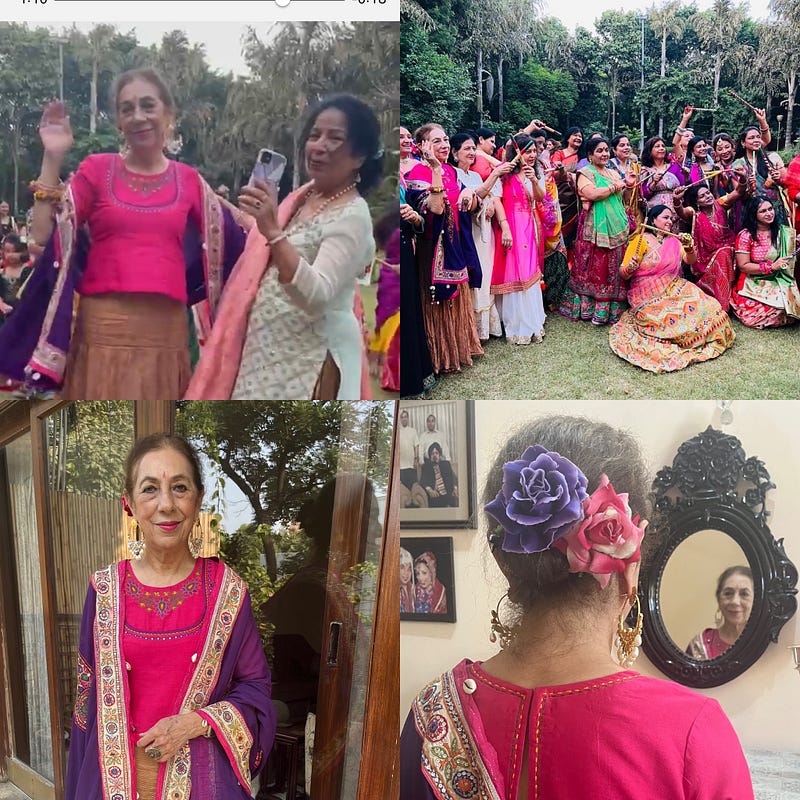CULTURE|FESTIVITIES|JOY
Harmony in Motion. Dandia Dancing for Positivity
The dance of the inner senses.

Dancing brings positivity and happiness to people. It completely changes the environment. If you are sitting quietly in the corner and the music plays then with the beats, it feels light and good.
It is like meditation and happiness with the inner self. Then the beats make you exuberant and it gives a lot of joy.
Dandiya’ is a dance form performed during the time of the 9 days of fasting called Navratri, in India. It has its origins in Gujarat but its vibrancy has spread throughout the country.
Navaratri is an annual Hindu festival observed in honor of the goddess Durga, the incarnation of Adi Parashakti, the supreme goddess. It spans over nine nights, first in the month of ChaitraMarch/April of the Gregorian calendar), and again in the month of Ashvin (September–October).
The dance comprises bamboo sticks painted in bright colors. The dance involves the rhythmical striking of the Dandiyas or sticks. This is why it is popularly called stick dance.
Each dancer participating in the Dandiya dance carries small decorated wooden sticks. These are struck in the rhythm of the music according to the beats.
It was originally performed in honor of Goddess Durga, the dance form represents a battle between the demon Mahishasura and the Goddess. Also,
it was earlier performed only by men, who sometimes used swords instead of sticks in the dance performance. However, to make it more colorful it was made in honor of Goddess Durga, they decided to bring women within its fold and make it vibrant and happy for the whole community.

Interpretations of Dandia Raas/Dance
The rhythmical striking of the Dandiyas\ sticks has a symbolic meaning that is derived from Gujarati culture and Hindu legends. It has to be moved in harmony and when the two sticks meet you should hear the rhythm and the sound.
🌹The Dandiya Raas dancers waving the decorated sticks represent harvesters using their sickles on paddy fields. This interpretation is based on the belief that Navratri was once a harvest celebration.
🌹Another interpretation is that the Dandiya Raas dancers swirling around in circles with their sticks colliding in mid-air representing the warriors in the battle between Lord Ram and the Ravana in the Ramayana.
🌹Another legend states that the dance form originated from Krishna & Radha’s ‘raas leela’, hence the name ‘Dandiya Raas’.
Vibrant dresses
There is usually a dress code for this dance. Since it represents vibrancy and happiness and is supposed to spread joy to all around you the clothes are usually bright.
Women are dressed in three-piece attires called skirts with short tops with colorful long scarves. In India, we call it Lehanga, choli, and dupatta. These are usually decorative and beautiful.
Men wear the traditional Kurta or long shorts and dressy day wear Pajamas.
When the performers strike the wooden sticks in rhythmic beats, a drummer standing in the center of the circle commands the rhythm of the dance.
People assemble in circular formations. The circle keeps getting longer and then an inner circle is formed and then many circles are formed. Some move clockwise and others anti-clockwise.
Often Dandia is clubbed with another dance form from Gujarat and is called ‘Garba’.
The celebrations start after the performance of the ritual of ‘aarti’, which is like the beginning of the prayer or the festivities. whereas Garba is performed prior to it.
The celebrations
A social club for women of all ages called Madhur Milan Club celebrates a lot of festivals. In fact, it should have been around the 15th of October but every club wishes to do this function because of the popularity that the programs receive.
So this program was held yesterday the 7th of October 2023. The weather was cool. People looked very festive and it gave inner and outside positivity and happiness.
There are competitions galore. Schools and colleges have shows and programs and there is much merriment around. Earlier the North Indian Gidda and Bhangra dances were popular but now Garba and Dandia have taken on the new popularity tag.
The idea is to spread happiness and positivity. When you see colors and vibrancy automatically the air is filled with a scent of happiness lifting our spirits up in the air.
There is an inner sense of well-being, love, and peace. It is a joy of wellbeing.
Perhaps you would like to read and self-reflect like Motaz Majed "My To-Do List is Laughing at Me!!!"
Muhammad Nasrullah Khan’s beautiful love poem:
©Dr. Preeti Singh, 2023.
Connect with me Click here to subscribe to my stories| Connect on Medium link Dr. Preeti Singh |Facebook Instagram Linkedin Email: [email protected]






